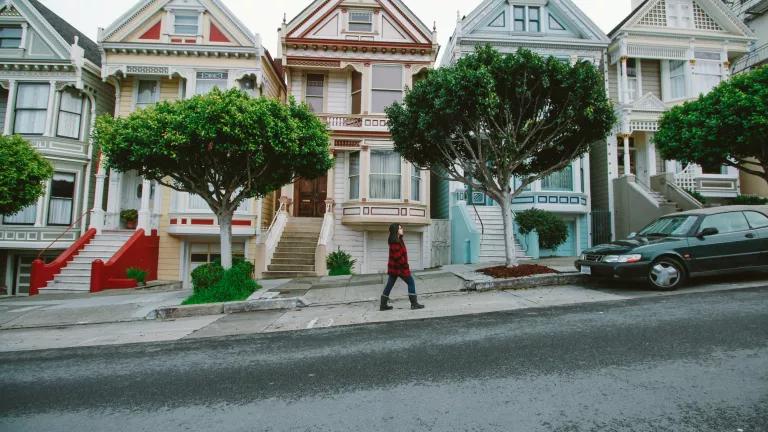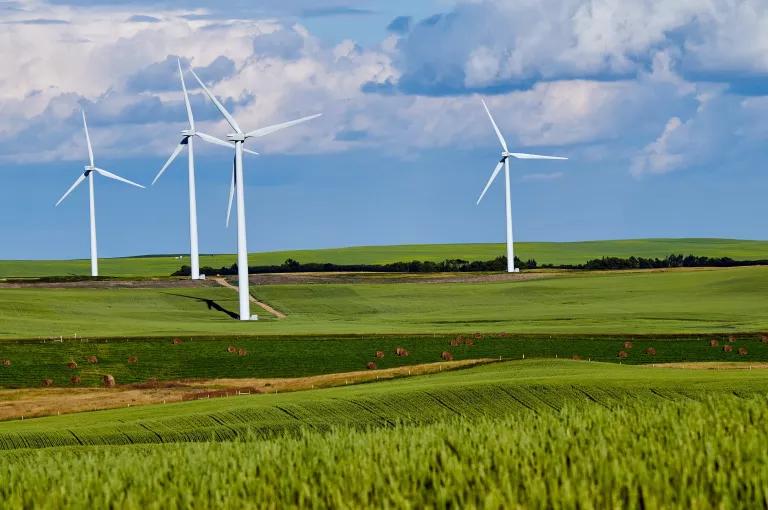CA Clean Buildings Progress Report: 2022
California’s progress offers a roadmap for transitioning to healthy, clean, and efficient buildings. What's next for the decarbonization leader?

Belle Co on Pexels
This blog is part of NRDC’s Year-End Series Reviewing 2022 Climate & Clean Energy Developments.
California solidified its position as a climate leader this year – securing more than $1 billion in the state budget for clean and healthy homes, establishing clean buildings targets, and eliminating outdated incentives to connect new properties to the gas system.
Decarbonizing our buildings is an urgent task. Nationwide, buildings account for nearly 40 percent of greenhouse gas (GHG) emissions. Cost-effectively cutting these emissions requires replacing gas-burning appliances with clean, highly-efficient electric appliances powered by the increasingly renewable electric grid. Because gas heating appliances have a lifespan of about 15 years, we only have one or two shots per home to replace burnt-out gas appliances with clean electric ones before our 2045 climate neutrality deadline.
California’s actions throughout the past year offer a roadmap to other states looking to transition to healthy, clean, and efficient buildings. Up next for the decarbonization leader? Proving that California can strategically implement state and federal funding to achieve an equitable, all-electric future. Read on to understand California’s pathway to its 2022 wins and the work that lies ahead.
California’s Theory of Change
California’s building decarbonization policies are geared towards a common goal: transitioning buildings to efficient, all-electric appliances. All-electric appliance standards are the most cost-effective way to scale electrification in existing buildings. But before standards can be adopted, the state must ensure that these products are available and affordable.
This is where California’s suite of policies comes in. Incentive programs, electric rate reform, new construction standards, and heat pump targets all aim to ready the state for the all-electric future. They seek to educate consumers about electric technologies, develop the workforce needed to deploy these technologies, and ensure that households save money on their bills when they make the switch. They also aim to reach low-income households, who are least able to afford the upfront costs of home electrification.
By 2030 – the California Air Resources Board’s (CARB) proposed date for an all-electric space and water heating standard – existing and future policies must ensure that electric appliances are accessible to all households and businesses.
The Policy and Program Roadmap
California is on a clear path to achieving state climate goals via a transition to highly-efficient electric appliances—a path that has the added benefits of improving safety, health outcomes, and air quality. Policy measures since 2018 have laid the groundwork for an equitable transition and offer a roadmap to other states endeavoring to cut building emissions.
Foundational Legislation
In 2018, Assembly Bill (AB) 3232 required the California Energy Commission (CEC) to assess how to cut building emissions 40 percent by 2030. Senate Bill (SB) 1477 established and provided initial funding for two building electrification programs, the Building Initiative for Low-Emissions Development (BUILD) and Technology and Equipment for Clean Heating (TECH) programs. In 2022, these programs installed electric heat pumps in new and existing buildings across the state.
Transforming Energy Efficiency Funding
In 2019, an update to a decades-old policy enabled the California Public Utilities Commission’s (CPUC) efficiency programs to fund “fuel substitution” measures that replace gas appliances with efficient electric appliances. This year, the CPUC established new and updated rules that value the climate benefits of fuel switching.
One policy adopted, the Avoided Cost Calculator, considers the climate costs that are avoided by switching away from gas appliances. Another key policy, the Total System Benefit metric, enables the CPUC to account for the benefits of distributed energy resources (DERs) such as grid-flexible heat pumps, including climate and reliability benefits. These updated rules allow the CPUC to evaluate gas and electric measures based on their full costs and benefits to society, resulting in smarter utility spending.
“Reach Code” Cities
More than 70 local jurisdictions have adopted electric-friendly “reach codes” to the current state building code. In 2022, cities ranging from Los Angeles and Glendale in Southern California to Martinez and Pleasanton in the Bay Area adopted new codes. These cities have not only pushed California to reduce its reliance on polluting fossil fuels in buildings, but also led the way for cities as large as New York to make similar climate commitments.
All-Electric Friendly Building Code
California’s new, electric-friendly state building code, adopted in 2021, will encourage all-electric new construction and require “all-electric ready” new construction beginning in 2023. While builders will still be allowed to use gas appliances in new buildings, they will be required to offset the higher emissions with more efficiency measures.

Photo by Abby Anaday on Unsplash
Advancements in 2022
Policy advancements in 2022 solidified California’s role as a clean buildings leader, with bold new targets and actions.
Governor Newsom’s Clean Building Goals
In July, Governor Newsom wrote a letter to CARB that set targets of 6 million heat pumps in buildings and 3 million climate-ready and climate-friendly homes by 2030. At least 50 percent of the funding to meet these goals must be directed toward disadvantaged communities.
Zero-Emission Appliance Standard
CARB’s State Strategy for the State Implementation Plan, adopted in September 2022, establishes a zero-emission standard for new residential space and water heating appliances starting in 2030. The ambitious yet critical timeline challenges California to adopt and fund programs as needed to make electric appliances accessible and cost-competitive by this date.
End to Subsidies for New Gas Connections
Beginning in July 2023, the CPUC will eliminate subsidies to connect new properties to the gas system. The decision is premised on a simple fact about California’s energy future: “Any new gas infrastructure is likely to become a stranded asset.”
Low-income customers – who are least able to afford to transition to electric appliances without assistance – are most likely to be left paying for these “stranded” costs as better-resourced customers depart the gas system, unless proactive steps are taken to avoid this outcome. The decision is a win for the climate, equity, and gas utility customers, and it is leading the way for other states to consider similar rule changes.
Electric Rate Reform
The June 2022 energy budget trailer bill (AB 205) requires the CPUC to oversee the adoption of “income-based fixed charges” to align electric rate design with California’s climate goals. Current, “volumetric” electric rates overcharge customers for each additional unit of electricity they consume. This disincentivizes building electrification by requiring all-electric households to pay more than their fair share of fixed electric system costs. Implementing an “income-based fixed charge” will lower volumetric electric rates and make building electrification more cost-effective for customers.
Incentive programs
An array of building decarbonization programs are marshaling local, state and federal resources toward the deployment of clean and efficient electric appliances. The following are some of the programs established or expanded in 2022.
Equitable Building Decarbonization Program: The 2022 State Budget and future year commitments will provide $922M over four years to the CEC for equitable building electrification: $622M for a low-income direct install program and $300M for statewide incentives.
Inflation Reduction Act: The historic Inflation Reduction Act (IRA) will provide $582M to the CEC for the HOMES and HEEHRA programs, which will provide rebates for home energy efficiency and electrification with a focus on low- and middle-income households. The state and California non-profits can also apply for Contractor Training Grants, Greenhouse Gas Reduction Fund loans, and other IRA funding. Additionally, households can take advantage of electrification and efficiency tax credits.
California Schools Healthy Air, Plumbing, and Efficiency Program (CalSHAPE): The 2022 State Budget provides $20M for the HVAC replacement phase of the CalSHAPE program (previously un-funded), limited to “near-zero-emission building technology.”
TECH Clean California: TECH Clean California is a $120M initiative to transform the market for electric heat pumps through incentives, pilot projects, and quick start grants. The 2022 State Budget sets aside an additional $50M for TECH in FY22-23, with an additional $95M commitment in FY23-24.
California Electric Homes Program (CalEHP): CalEHP dedicates $75M to all-electric market rate construction, which will launch in 2023.
The Self-Generation Incentive Program (SGIP): The SGIP Heat Pump Water Heater (HPWH) Program will dedicate $84.7M to equity-focused residential and commercial HPWH installations, which will launch in 2023.
The Wildfire and Natural Disaster Resiliency Rebuild (WNDRR) Program: The $50M WNDRR Program will provide electrification incentives to homeowners of post-disaster, red-tagged homes, with higher incentives for occupants of low-income or historically disadvantaged communities, which will launch in 2023.
Affordable Housing and Sustainable Communities (AHSC) Program: The AHSC Program, which provides funding to selected affordable housing projects, is helping expand access to all-electric housing by offering “points” for all-electric design. In 2022, all but one of 37 selected projects received maximum points for electrification.
Community Resilience Centers: The 2022 State Budget and future year commitments will provide $270M for the Community Resilience Centers program, which will upgrade or build vital gathering places (including community centers, libraries, and schools) with efficient electric technology, energy efficiency, renewables, and storage.
Next Steps
2022 was a big year for building electrification. Historic state and federal investments, combined with policy changes and bold heat pump targets, are the product of years of partnership and advocacy. The programs and policies already underway, and those that will kick off shortly, provide a blueprint for the future—and give us hope that California and other states can achieve meaningful climate action in a way that benefits communities across the country.
While California’s initial success should be celebrated, this is also no time to slow down. Equitably decarbonizing all of California’s buildings—and achieving economy-wide decarbonization—will require coordination across the state’s agencies and a commitment from the state to deliver on future year budget commitments for building electrification.
Policies and Programs Breakdown
| Policy | Description |
| Foundational Legislation | Adopted in 2018, AB 3232 required the CEC to assess how to cut buildings emissions 40 percent by 2030. SB 1477 established and provided initial funding for the BUILD and TECH programs. |
| Leveraging Energy Efficiency Funding | In 2019, an update to a decades-old policy enabled the CPUC efficiency programs to fund “fuel substitution” measures that replace gas appliances with efficient electric appliances. |
| Reach Code Cities | Since 2019, more than 70 local jurisdictions have adopted electric-friendly “reach codes” to the current code. |
| All-Electric Friendly Building Code | California’s new, electric-friendly state building code will encourage all-electric new construction and require “all-electric ready” new construction starting in 2023. |
| Zero-Emission Appliance Standard | In Sept 2022, CARB adopted a zero-emission standard for new, residential space and water heating appliances starting in 2030. |
| Governor’s Clean Buildings Goals | Governor Newsom’s letter to CARB in July 2022 set targets of 6M heat pumps in buildings and 3M climate-ready and climate-friendly homes by 2030. 50 percent of the funding to meet these goals must be directed towards disadvantaged communities. |
| End to Gas Line Extension Allowances | The CPUC will eliminate subsidies for developers to connect new properties to the gas system beginning in July 2023. |
| Rate Reform Legislation | The June 2022 energy budget trailer bill (AB 205) requires the CPUC to oversee the adoption of income-based fixed charges, which would lower volumetric electric rates and make building electrification more economic. |
| Avoided Costs of Gas Carbon Reduction | This year, the CPUC adopted a methodology that values the avoided costs, or benefits, of carbon reduction from gas appliances. This aligns the avoided costs of carbon reduction from the gas sector with the total costs of achieving our gas sector decarbonization goals. |
| Total System Benefits (TSB) Metric | The TSB is a fuel neutral metric to value, set goals for, and track achievements of distributed energy resources (DERs). The TSB accounts for the energy system and climate policy benefits of DERs, including building electrification. |
| Reducing Costs of Electric Upgrades | SB 68, passed in 2021, directs the CEC to gather and develop resources to avoid or reduce electric panel and electric service upgrade costs for building and transportation electrification. |
| Program | Description |
| Equitable Building Decarbonization Program | The 2022 State Budget and future year commitments will provide $922M over four years to the CEC for equitable building decarbonization: $622M for a low-income direct install program and $300M for statewide incentives. [CEC] |
| Inflation Reduction Act | IRA will provide $582M to the CEC for the HOMES and HEEHRA Programs. The state and California non-profits can also apply for Contractor Training Grants, Greenhouse Gas Reduction Fund loans, and much more. Additionally, households can take advantage of electrification tax credits. [CEC primarily] |
| Building Initiative for Low-Emissions Development (BUILD) Program | The $80M BUILD Program provides incentives and technical assistance to construct all-electric affordable housing. [CEC] |
| CA Electric Homes Program (CalEHP) | CalEHP dedicates $75M to all-electric market rate construction. [CEC] |
| CA Schools Healthy Air, Plumbing, and Efficiency Program (CalSHAPE) | The 2022 State Budget provides $20M for the HVAC replacement phase of the CalSHAPE program (previously un-funded), limited to “near-zero-emission building technology.” See 3360-101-3228 in AB 179. [CEC] |
| TECH Clean California | TECH Clean California is a $120M initiative to transform the market for electric heat pumps through incentives, pilot projects, and quick start grants. The 2022 State Budget sets aside an additional $50M for TECH in FY22-23, with another $95M commitment in FY23-24. [CPUC] |
| The Self-Generation Incentive Program (SGIP) | The SGIP Heat Pump Water Heater (HPWH) Program will dedicate $84.7M to equity-focused residential and commercial HPWH installations. [CPUC] |
| San Joaquin Valley Pilots | The San Joaquin Valley Pilot Programs are an initiative to replace wood and propane appliances in nearly 2,000 homes in the San Joaquin Valley, with $47.4M dedicated to offering climate-friendly electric appliances. [CPUC] |
| The Wildfire and Natural Disaster Resiliency Rebuild (WNDRR) Program | The $50M WNDRR Program will provide electrification incentives to homeowners of post-disaster, red-tagged homes, with higher incentives for occupants of low-income or historically disadvantaged communities. [CPUC] |
| WatterSaver Program | WatterSaver is a PG&E initiative to replace water heaters with demand-flexible electric heat pump models. [CPUC] |
| CPUC Energy Efficiency Programs | In 2019, an update to a decades-old policy enabled the range of CPUC efficiency programs to fund “fuel substitution” measures that replace gas appliances with efficient electric appliances. |
| Energy Savings Assistance Program | ESAP offers qualifying low-income households the opportunity to perform energy efficiency upgrades at no charge. In 2021, the CPUC approved $51.3M through ESAP to two Southern California Edison (SCE) building electrification-focused pilots: the Building Electrification Pilot ($40.8M) and the Clean Energy Homes Pilot ($10.5M). [CPUC] |
| Southern California Edison’s (SCE) Electrification Program | In addition to SCE’s ESAP programs, SCE has submitted a $677M proposal to the CPUC for residential and commercial electrification programs. [CPUC] |
| Affordable Housing and Sustainable Communities (AHSC) Program | The AHSC Program is helping expand access to all-electric affordable housing by offering “points” all-electric design. All but one of the 37 projects selected last year received maximum points for electrification. [Strategic Growth Council (SGC)] |
| Community Resilience Centers | The 2022 State Budget and future year commitments will provide $270 million for the Community Resilience Centers program, which will upgrade or build vital gathering places (community centers, libraries, schools, etc.) with efficient electric technology, energy efficiency, renewables, and storage. [SGC] |
| Local and regional programs |
Local governments, publicly owned utilities, community choice aggregators (CCAs) and others are also deploying a range of local programs. A few examples:
|





